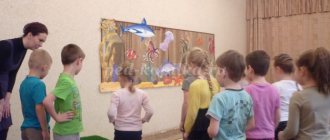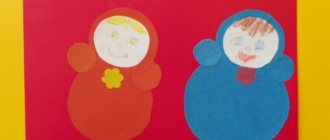Ethical conversations with older preschool children
Conducting an ethical conversation with children of senior preschool age
One of the forms of training and education of preschoolers is ethical conversations, which help children master the norms and rules of moral behavior.
The teacher prepares, conducts and directs the conversation. During the conversation, the adult not only asks questions for discussion, but also looks for the main thing that stimulates the children’s desire to think, express their point of view, and prove it.
Ethical conversation, as a method of moral education, is distinguished by its significant originality. The content of ethical conversations consists mainly of genuine life situations, the behavior of people around them and, above all, the students themselves. The teacher characterizes the facts and actions that the child observed or performed in communication with peers and adults.
Such characteristics form in children objectivity in assessing events, help the child navigate a given situation and act in accordance with the rules of moral behavior.
Ethical conversations are planned, prepared and organized classes, the content of which is determined by the requirements of the program. But, turning to the program objectives of education, the teacher must specify them, work out the rules and norms of behavior, the education of which must be strengthened in this group, taking into account adults and the individual characteristics of children.
The number of such conversations is small: five to seven per year, i.e. once for one and a half to two months. The main goal of ethical conversations is to form in the child moral motives of behavior that he could guide in his actions. And such conversations should be based, first of all, on genuine events and phenomena, which are abundantly provided by the life and activities of a child among his peers.
When preparing for such a conversation, the teacher must analyze what was the subject of the children’s most vivid impressions, how they perceived what they saw, how they experience it. If a teacher considers it necessary to include excerpts from a particular work of art into an ethical conversation, he must necessarily subordinate their content to educational functions.
If the content of the conversation is accessible and interesting, then children ask questions, they have vivid emotions and assessments. This allows you to reasonably determine how the kids perceived the idea, the moral of the work, and makes it possible to further tactfully correct the children’s behavior. And the fact that the whole group of children jointly discuss the facts of behavior and various situations evokes empathy, the emotional influence of children on each other, and contributes to the mutual enrichment of their feelings and ethical ideas.
The behavior of pupils in older groups convincingly indicates that at this age there is a gradual transition from the perception of the content of individual actions to enriched concepts of good behavior. Through ethical conversations, the teacher connects disparate ideas in the minds of children into a single whole - the basis of a future system of moral assessments. It is the assimilation of ethical concepts in a certain system that helps an older preschooler understand the essence of the concepts of goodness, common good, and justice that forms the initial concept of human dignity.
In the senior group of kindergarten, it is advisable to hold conversations on the topics: “Can we be friends?”, “Learning to help our comrades,” “About justice,” etc.
The methodology for conducting ethical conversations was developed by V. G. Nechaeva, S. V. Peterina, I. N. Kurochkina and other researchers. Research by E. R. Smirnova and V. M. Kholmogorova established that true morality develops in preschool age not through self-awareness and not through the assimilation of moral norms, but through the cultivation of a special vision of the other and attitude towards him.
Thus, the integrated use of methods and techniques of education, aimed not only at mastering the rules and norms of behavior, but at developing belonging, a sense of community with others, will help in truly nurturing a culture of behavior in children of senior preschool age.
As children master this form of communication with the teacher and among themselves, we can talk about dialogue between the participants in the conversation. The teacher should strive for this when organizing an ethical conversation.
Dialogue is a form of communication, a conversation between two or more people, during which personal relationships arise, such as: accepting the identity of the interlocutor, the ability to listen and hear another, reaction to a statement, the desire to understand the interlocutor, the ability to correctly express one’s thoughts.
Children’s positive attitude towards conversation is achieved through:
- posing questions that are understandable to children and practically important for them, related to their everyday experience;
- presenting the material in a figurative form that can arouse the interest of preschoolers and attract their attention. For this purpose, works of art and examples of their life are used during conversations. They help to convey moral standards to children in a vivid manner. The use of proverbs during a conversation helps preschoolers to penetrate (although not immediately) into the essence of the rules contained in them. To do this, it is necessary to associate the proverb with specific situations familiar to children;
- encouraging the activity of children, their desire to take part in the conversation (for this purpose, the adult corrects the child’s statement, helping to adequately express the thought, supporting various judgments, if possible controversial, requiring arguments).
The teacher should always feel how much this form of work enriches and engages the children. Children love it when adults read to them. They strive to communicate with them, experience feelings of satisfaction and even pride when answering questions and receiving approval, especially if the adult outlines the importance of the issues being discussed. If an adult does not support the children’s emotional attitude to the conversation and does not talk about its importance, there is a danger of formalizing this type of work.
An essential factor that the teacher focuses on when assessing the effectiveness of the conversation is the activity of the children, their desire to speak out, argue, and prove. In the conversation, the teacher connects the rules and norms of behavior with patterns that are understandable to preschoolers. Frequent use of general formulations, didacticism, and didacticism are dangerous for fruitful, effective work with children.
In classes on speech development, familiarization with the outside world, and visual arts, the teacher teaches preschoolers to observe, identify individual signs of objects and phenomena, identifying the most significant ones. Children learn to analyze, compare, generalize, differentiate, etc. The teacher is guided by these mental operations in the process of ethical conversation, only moral situations serve as material for them.
An ethical conversation helps to draw children's attention to the inner world of a person (his thoughts, experiences), the world of human relationships, which are manifested in good and evil deeds. At preschool age, all these moral categories appear before the child in the form of images, ideas about good and bad.
Children learn that human relationships are subject to certain rules that must be followed. The idea of the need to obey the rules of the community, which help to live in harmony with others and with oneself, is mastered by children with the help of various images and examples, which in the minds of preschoolers are gradually generalized into the rule: one must help others when they need it; the one who helps does good, does a good deed. An adult helps make such a generalization by directing the statements of children answering questions that arise during the conversation.
In a conversation, the facts and events discussed are assessed. A positive assessment reinforces certain forms of behavior, while a negative assessment is intended to inhibit undesirable actions. The imitative ability of preschoolers gives rise to the desire to follow what is approved and avoid what is condemned. A positive image becomes a guide for the child in choosing an action.
Based on the materials of the conversation, children can make a drawing, come up with a story, a fairy tale, name a work, etc. (these tasks are optional). Children's creative work significantly increases the effectiveness of their assimilation and comprehension of moral concepts. In addition, drawings and good names can be used in everyday work, for example, an exhibition of drawings allows you to remind one or another rule. The same role can be played by a proverb or a line of a poem (“I will do well and not be bad”).
Often, preschoolers’ knowledge of correct behavior and the actions themselves do not coincide. It `s naturally. Children are still poorly oriented in various situations and do not know how to adequately assess their intentions and actions. In addition, children are prone to emotional outbursts, cannot cope with their desires (“I want”), sometimes show stubbornness, protest, etc. But all these facts are not grounds for denying the importance of “verbal” education.
Moral consciousness is the basis of moral behavior. It is necessary to lead children to this on the basis of the material that is available to them and those forms of work that will interest them and will contribute to moral development. At the same time, we must remember that ethical conversation is only one of the forms of the teacher’s work on the formation of the child’s moral consciousness. It is combined with various types of practical, playful activities of preschoolers, exercises aimed at developing moral consciousness and behavior.
During the ethical conversation, we strive to solve the following problems:
- Teach children to see the moral side of perceived actions and events, to understand their essence;
- Give ideas about the moral side of human relations, based on the actions of children, images of fiction and other forms of art;
- To promote the accumulation and generalization of an emotionally positive attitude towards the images of good heroes and their actions;
- To develop the ability to reasonably evaluate one’s own actions and the actions of other people (“possible – not possible”, “good – bad”);
- Teach to observe moral standards of behavior.
These tasks are also adopted by the teacher, depending on the level of development of preschoolers, their interest in the material, and their activity in solving problems that the teacher sets for them.
Ethical conversations are gradually becoming more complex both in content and in the way the material is presented. If in the middle group the emphasis is on the emotional response of children, then in the senior and preparatory groups preschoolers themselves try to draw conclusions from the moral situation under discussion. The teacher selects topics that are most relevant at the moment for children of a particular age.
The duration of conversations with children 4 - 5 years old is 20 minutes, with children 6 - 7 years old - 30 - 35 minutes. In addition, you need to pay attention to the activity of children, their interest. If interest in the conversation begins to wane, it is better to end it early on a high note. The end of the conversation should be brief, but interesting, emotional, bright (a funny story, a poem, a short excerpt from a cartoon, a playful song, a game). It would be good if the end of the conversation contained material for the next conversation.
The number of children participating in an ethical conversation depends on the age and experience of preschoolers participating in this type of work.
By the end of preschool age, during ethical conversations, children accumulate initial ideas about moral standards, moral choice (everyone decides for themselves what to do: confess to an offense or not, give in to a friend or not), the motive for an action, and they also master the following skills:
- are able to see the moral side of a given situation;
- be able to evaluate your own actions and the actions of other people;
- correctly use moral concepts (polite, truthful, caring, good friend, etc.) and their opposites;
- can correctly choose the word (from those proposed) that most accurately characterizes the hero’s action;
- when working with a work, they can choose a title, change the end of the story to a positive one; continue the story (as the hero did);
- explain the meaning of familiar proverbs;
- can compose a story or fairy tale by analogy.
Not all children master the listed skills. In preschool age, they only accumulate basic ideas about moral standards, which require further work to systematize and deepen them.
Ethical conversation for senior preschool children “Memory of the War”
Program content:
improve children's understanding of war; promote the formation of a sense of patriotism in children of senior preschool age; teach children to write stories about the war.
Develop monologue speech and coherent statements of children; strengthen the ability to answer questions in complete sentences.
Cultivate a friendly and caring attitude towards all people around you, and especially towards your relatives and family.
Vocabulary work:
friendly, caring, attentive, affectionate, generous, generous.
Watch a video for the song “Children of War” performed by T. Gverdtsiteli (lyrics by I. Reznik, music by O. Yudakhin)
Progress of the conversation:
— Guys, now I’ll read you a story by Andrei Platonov
"Little Soldier"
Not far from the front line, inside the surviving station, Red Army soldiers who had fallen asleep on the floor snored sweetly; the happiness of relaxation was etched on their tired faces.
On the second track, the boiler of the hot duty locomotive quietly hissed, as if a monotonous, soothing voice was singing from a long-abandoned house. But in one corner of the station room, where a kerosene lamp was burning, people occasionally whispered coaxing words to each other, and then they too fell into silence. There stood two majors, similar to each other not in external features, but in the general kindness of their wrinkled, tanned faces; each of them held the boy's hand in his own, and the child looked pleadingly at the commanders. The child did not let go of the hand of one major, then pressed his face to it, and carefully tried to free himself from the hand of the other. The child looked about ten years old, and he was dressed like a seasoned fighter - in a gray overcoat, worn and pressed against his body, in a cap and boots, apparently sewn to fit a child’s foot. His small face, thin, weather-beaten, but not emaciated, adapted and already accustomed to life, was now turned to one major; the child's bright eyes clearly revealed his sadness, as if they were the living surface of his heart; he was sad that he was being separated from his father or an older friend, who must have been a major to him.
The second major drew the child by the hand and caressed him, comforting him, but the boy, without removing his hand, remained indifferent to him. The first major was also saddened; and he whispered to the child that he would soon take him to him and they would meet again for an inseparable life, but now they were parting for a short time. The boy believed him, but the truth itself could not console his heart, which was attached to only one person and wanted to be with him constantly and close, and not far away. The child already knew what distance was like during the war - it is difficult for people from there to return to each other - so he did not want separation, and his heart could not be alone, it was afraid that, left alone, it would die. And in his last request and hope, the boy looked at the major, who must leave him with a stranger.
“Well, Seryozha, goodbye for now,” said the major whom the child loved. “Don’t really try to fight, when you grow up, you will.” Don’t interfere with the German and take care of yourself so that I can find you alive and intact. Well, what are you doing, what are you doing - hold on, soldier!
Seryozha began to cry. The major picked him up in his arms and kissed him on the face several times. Then the major went with the child to the exit, and the second major also followed them, instructing me to guard the things left behind.
- And now, dear children, let's change the end of the story (It must be positive)
— Let's talk about the lives of children during the difficult war years?
— Tell us about your parents, who are always there for you?
— How hard was it for little Seryozha to part with someone close to him?
Fizminutka
Let's raise our hands up - once above the nose, above the eyes. Keep your arms straight up, don't swing. don't tremble. Three - put your hands down, Stand still, don’t move around. Up one, two, three, four, down! We repeat, don’t be lazy! We will make turns. Do everything willingly. One - turn left, Two - now vice versa. So, without any haste, repeat 2 times. Hands on the belt, legs wider!
Educator.
It’s good that we don’t know war...
It’s good that we don’t know war. We grow, we live, we laugh and we play. We look with a smile at the blue sky, And catch fast roach in the rivers.
And we remember how brave fighters - Soldiers - brothers, grandfathers and fathers bravely defended the good world for us. So that we don’t see the war, don’t know.
Let's summarize our conversation.
- What did we talk about today?
—What good do you think war can bring?
— Next time I’ll tell you about how soldiers planted potatoes in the summer, and the story is called “Gardeners” by Sergei Alekseev.
State budgetary preschool educational institution of the city of Sevastopol
"Kindergarten No. 91 combined type"
Consultation for educators:
“Ethical conversations with children of senior preschool age”
Prepared by:
teacher
Group No. 6
Nesterak V.N.






